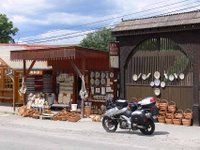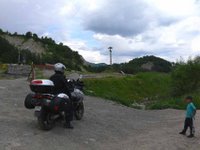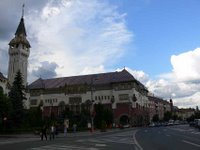
Over the past few weeks we spent some time traveling in Szekely Land (Secuime). With more than 90% of this Transylvanian region living and communicating in Hungarian, it is difficult for foreign travelers to make sense of the language, particularly since it is not related to any of the main European languages (its closest, albeit quite distant, relative is Finnish). The village and town signs are in both Romanian and Hungarian. However, most people in stores and restaurants greet you in Hungarian.
 Arriving into Odorheiu Secuiesc (Szekelyudvarhely), we felt the bustle of a growing town, due in large part to the redevelopment of textiles, furniture, and leather companies. The 16th century citadel is almost fully intact allowing visitors to wander within its walls. Interestingly too, Odorheiu Secuiesc has two Greco-Catholic, three Hungarian Reformed, two Orthodox, and four Roman Catholic churches!
Arriving into Odorheiu Secuiesc (Szekelyudvarhely), we felt the bustle of a growing town, due in large part to the redevelopment of textiles, furniture, and leather companies. The 16th century citadel is almost fully intact allowing visitors to wander within its walls. Interestingly too, Odorheiu Secuiesc has two Greco-Catholic, three Hungarian Reformed, two Orthodox, and four Roman Catholic churches!The small village of Corund (Korond) displays its well-known
 green, brown, and cobalt-blue pottery. While we certainly enjoy the Corund pottery, we were very disappointed with the village. Covered from entry to exit with dusty, cramped, roadside kiosks similar to those found all over the rest of Romania, Corund was merely overrun with tourists, tour buses, high prices, and, at times, questionable quality merchandise. While we had looked forward to seeing the town where the pottery is made, the trip was not worth the effort and expense.
green, brown, and cobalt-blue pottery. While we certainly enjoy the Corund pottery, we were very disappointed with the village. Covered from entry to exit with dusty, cramped, roadside kiosks similar to those found all over the rest of Romania, Corund was merely overrun with tourists, tour buses, high prices, and, at times, questionable quality merchandise. While we had looked forward to seeing the town where the pottery is made, the trip was not worth the effort and expense. Praid is known for its therapeutic salt mines. One hundred twenty meters below the surface, the legendary mines are known for the benefits they provide for respiratory ailments. While looking for the entrance to the mines, we followed a sign leading us down a dirt road. About 2 kilometers down this road, we were chased by guard dogs and kids, who clearly had not seen such a sight in a long while. And along with the guard dogs, we encountered two serious looking guys bearing black T-shirts emblazoned with SECURITY. Oooops!!!!! Is the tourist business so in demand here??? Is there a mine dance club with VIPs near here??? Oh, no, not quite--we had arrived at the old commercial mines, which were still owned by a company and ergo guarded. Hmm... I guess no salt treatments here, then....
Praid is known for its therapeutic salt mines. One hundred twenty meters below the surface, the legendary mines are known for the benefits they provide for respiratory ailments. While looking for the entrance to the mines, we followed a sign leading us down a dirt road. About 2 kilometers down this road, we were chased by guard dogs and kids, who clearly had not seen such a sight in a long while. And along with the guard dogs, we encountered two serious looking guys bearing black T-shirts emblazoned with SECURITY. Oooops!!!!! Is the tourist business so in demand here??? Is there a mine dance club with VIPs near here??? Oh, no, not quite--we had arrived at the old commercial mines, which were still owned by a company and ergo guarded. Hmm... I guess no salt treatments here, then....
Targu Mures (Marasvasarhely) developed as a cultural and academic center in the 14th century. It remains a vibrant city with its medical and theatre schools nationally renowned. Under Ceausescu, all ethnic groups other than Romanians were forbidden to live here. In fact, Romanians from other parts of the country were moved in to influence the Hungarian presence!
 Lined with Secession-style buildings, Targu Mures was a pleasant stop. The early 20th century Palace of Culture is eye catching with its steeple roofs, tiled with colorful geometric patterns. (Perhaps not quite coincidental, since the city boasts father and son mathematicians, Farkas and Janos Bolyai, revolutionaries of Euclidean geometry.) The Palace houses the history and art museums, as well as the stained glass window museum. There is also a concert hall boasting an organ with over 4500 pipes! The building next-door, the Prefecture cannot be missed with its bright green spire and tiled roof.
Lined with Secession-style buildings, Targu Mures was a pleasant stop. The early 20th century Palace of Culture is eye catching with its steeple roofs, tiled with colorful geometric patterns. (Perhaps not quite coincidental, since the city boasts father and son mathematicians, Farkas and Janos Bolyai, revolutionaries of Euclidean geometry.) The Palace houses the history and art museums, as well as the stained glass window museum. There is also a concert hall boasting an organ with over 4500 pipes! The building next-door, the Prefecture cannot be missed with its bright green spire and tiled roof.
Rains, thunder and lightning were moving in and sent us back to Sighisoara for the evening. We found lodging with a family in the citadel and had a wonderful conversation with a British traveler visiting Romania by train. Exchanging stories of his train experiences and our motorcycle adventures until 2 a.m. was much fun! – BGR & HSR

No comments:
Post a Comment